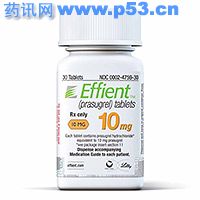制造商:
第一制药,三共株式会社和礼来公司
药理分类:
血小板P2Y12抑制剂(噻吩并吡啶)
活性成分(补):
普拉格雷5毫克,10毫克;标签。
指示(补):
为了减少对急性冠状动脉综合征患者血栓谁是心血管事件的危险性要与经皮冠状动脉介入(不稳定型心绞痛(UA)或非ST段抬高心肌梗死(NSTEMI)患者管理;与ST段抬高心肌梗死(STEMI患者)当小学或延迟PCI管理)。
药理作用:
普拉格雷是血小板活化和聚集抑制剂,其活性代谢物结合ADP的血小板P2Y12受体类。应当给予适当的时候每天服用阿司匹林,这可能与他汀类药物给予,地高辛,药物,增加胃pH值,糖蛋白IIb / IIIa抑制剂,与肝素。
临床试验:
在一个大型,随机,双盲,平行组研究中,使用普拉格雷比较氯吡格雷一疗程,每增加对阿司匹林和其他患者的标准治疗对急性冠状动脉综合征(尿酸,NSTEMI,或STEMI)的谁分别是与PCI管理。肝素糖蛋白IIb / IIIa抑制剂进行管理在治疗医生决定。口服抗凝血剂,其他血小板抑制剂,慢性NSAIDs类药物不允许的。术后随访至少6个月。
主要结果测量是心血管死亡,非致死性心肌梗塞,或心绞痛/ NSTEMI人口的非致命性中风的复合材料。普拉格雷显着降低总终点事件相比,氯吡格雷(主要是通过降低非致命性的多边机构)。治疗效果是在头几天,直到研究结束持续存在。
普拉格雷降低了主要复合氯吡格雷相比,无论是心绞痛/ NSTEMI和STEMI的人口终点的发生。
除了在某些高风险,如糖尿病,心肌梗塞前的情况下,普拉格雷不建议使用在75岁及以上的患者,由于对这个年龄组中增加出血的危险。数据显示,但是,普拉格雷可能会降低这些患者缺血事件的风险。
法律分类:
接收
成人:
负荷剂量:60毫克一次。保养:10毫克,每日一次。 <60公斤级:考虑5毫克,每日一次。以阿司匹林(75毫克- 325mg每天)。
儿童:
不推荐。
禁忌(补):
主动病理出血(如消化性溃疡,颅内出血)。在此之前TIA或中风。如果不启动紧急病人可能接受冠状动脉搭桥术。
警告/注意事项:
≥75yrs:通常不推荐。重量<60公斤级,或CABG或其他手术或创伤或严重肝功能障碍:增加出血的危险。手术前7天停止,如果TIA或中风的发生。过早停止增加风险(例如,支架血栓,心肌梗死,死亡)心脏事件。妊娠(Cat.B)。哺乳的母亲。
互动(补):
增加出血和肝素,华法林,纤维蛋白溶解,风险长期使用NSAID。
不良反应(补):
出血(可能是致命的),超或低血压,高血脂,头痛,背痛,肠胃不适,头晕,咳嗽,胸痛,房颤,白细胞减少症;罕见:血栓性血小板减少性紫癜,血小板减少,贫血,肝功能异常,过敏反应,血管性水肿。
如何提供:
制表5毫克- 7,30
10毫克,30,90
最后更新:
2009/8/19
EFFIENT
Manufacturer:
Daiichi-Sankyo and Lilly
Pharmacological Class:
P2Y12 platelet inhibitor (thienopyridine)
Active Ingredient(s):
Prasugrel 5mg, 10mg; tabs.
Indication(s):
To reduce risk of thrombotic cardiovascular events in patients with acute coronary syndrome who are to be managed with percutaneous coronary intervention (patients with unstable angina (UA) or non-ST-elevation myocardial infarction (NSTEMI); patients with ST-elevation MI (STEMI) when managed with either primary or delayed PCI).
Pharmacology:
Prasugrel is a platelet activation and aggregation inhibitor whose active metabolite binds the P2Y12 class of ADP receptors on platelets. It should be given with daily aspirin when appropriate, and it may be given with statins, digoxin, drugs that increase gastric pH, GPIIb/IIIa inhibitors, and heparin.
Clinical Trials:
In a large, randomized, double-blind, parallel-group study, the use of prasugrel was compared to a regimen of clopidogrel, each added to aspirin and other standard therapy in patients with acute coronary syndrome (UA, NSTEMI, or STEMI) who were to be managed with PCI. Heparin and GPIIb/IIIa inhibitors were administered at the discretion of the treating physician. Oral anticoagulants, other platelet inhibitors, and chronic NSAIDs were not allowed. Patients were followed for at least 6 months.
The primary outcome measure was the composite of cardiovascular death, nonfatal MI, or nonfatal stroke in the UA/NSTEMI population. Prasugrel significantly reduced the total endpoint events compared to clopidogrel (mostly by decreasing nonfatal MIs). The treatment effect was seen within the first few days and persisted until the end of the study.
Prasugrel reduced the occurrence of the primary composite endpoint compared to clopidogrel in both the UA/NSTEMI and STEMI populations.
Except in certain high-risk situations such as diabetes mellitus and prior MI, prasugrel is not recommended for use in patients 75 years of age and older due to an increased risk of bleeding in this age group. Data suggest, however, that prasugrel may reduce the risk of ischemic events in these patients.
Legal Classification:
Rx
Adults:
Loading dose: 60mg once. Maintenance: 10mg once daily. <60kg: consider 5mg once daily. Take with aspirin (75mg–325mg daily).
Children:
Not recommended.
Contraindication(s):
Active pathological bleeding (eg, peptic ulcer, intracranial hemorrhage). Prior TIA or stroke. Do not start if patient likely to undergo urgent CABG.
Warnings/Precautions:
≥75yrs: usually not recommended. Weight <60kg, or CABG or other surgery or trauma, or severe hepatic dysfunction: increased risk of bleeding. Discontinue 7 days before surgery, and if TIA or stroke occurs. Premature discontinuation increases risk for cardiac events (eg, stent thrombosis, MI, death). Pregnancy (Cat.B). Nursing mothers.
Interaction(s):
Increased bleeding risk with heparin, warfarin, fibrinolytics, chronic NSAID use.
Adverse Reaction(s):
Bleeding (may be fatal), hyper- or hypotension, hyperlipidemia, headache, back pain, GI upset, dizziness, cough, chest pain, atrial fibrillation, leukopenia; rare: thrombotic thrombocytopenic purpura, thrombocytopenia, anemia, abnormal hepatic function, allergic reactions, angioedema.
How Supplied:
Tabs 5mg—7, 30
10mg—30, 90


